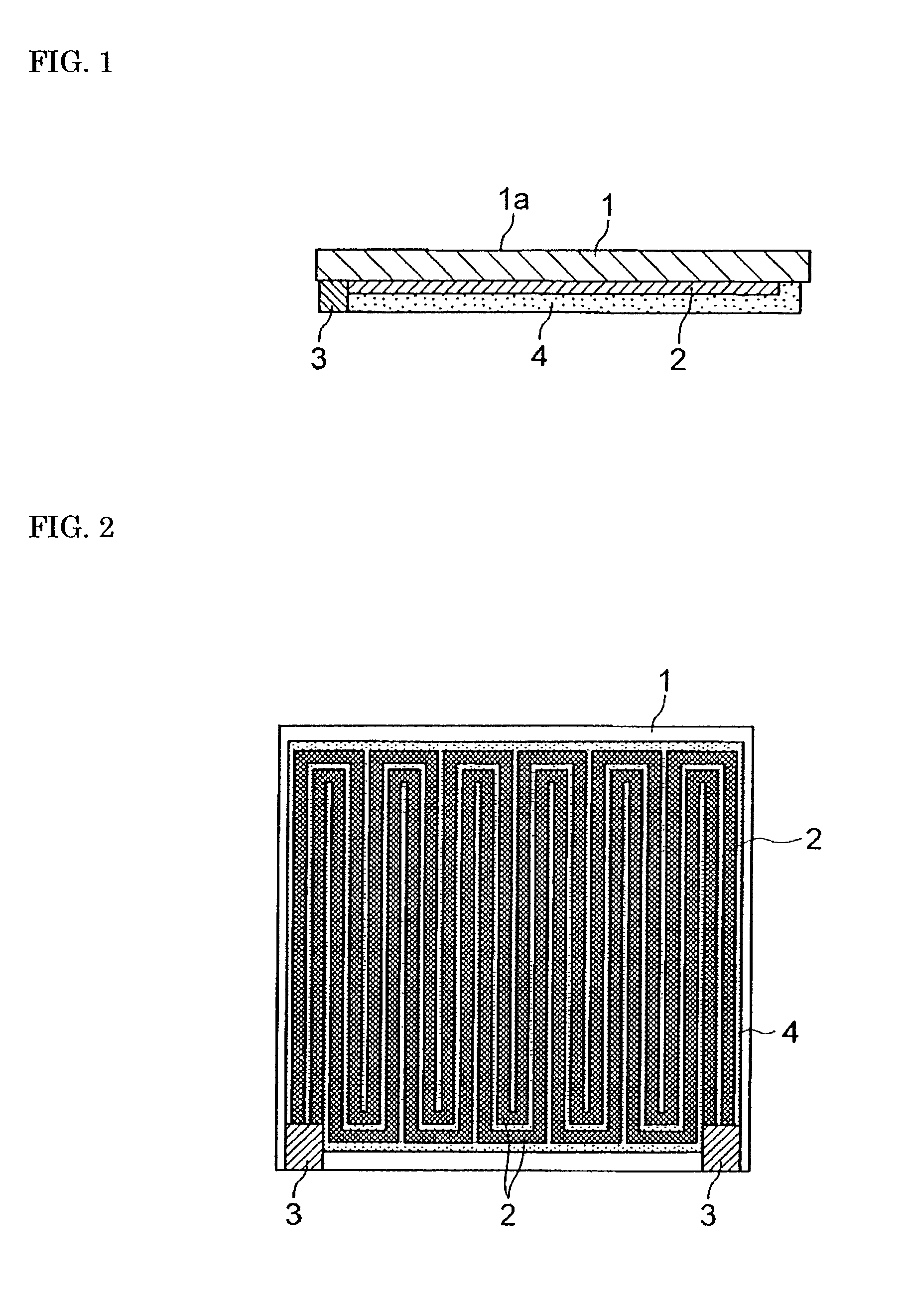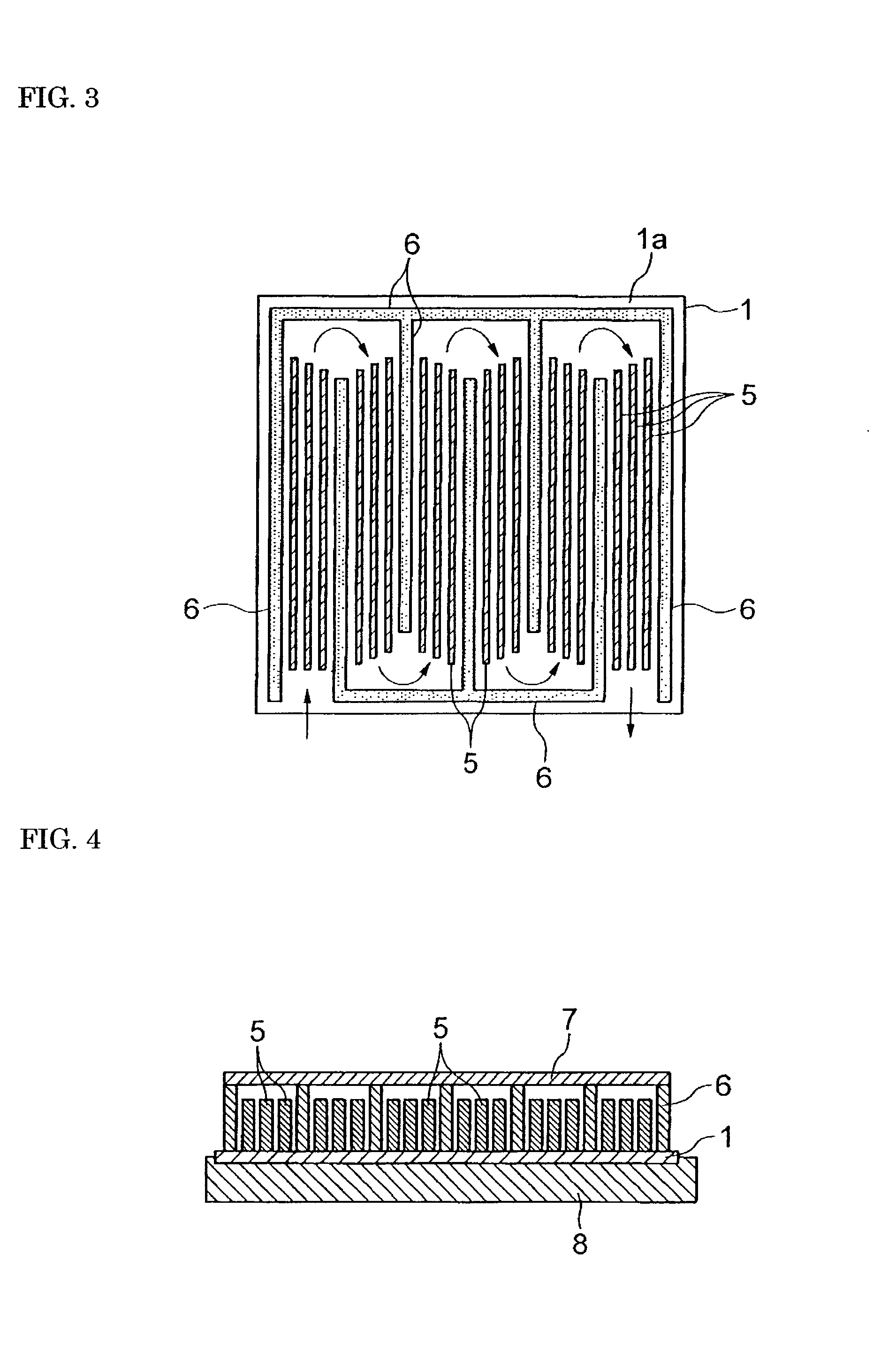Fluid heating heater
a heating heater and flue technology, applied in the field of flue heaters, can solve the problems of ceramic heaters that are easily damaged by thermal shock, do not necessarily have sufficient thermal efficiency, and have relatively high power consumption, so as to improve heat transfer efficiency, reduce power consumption, and increase the effect of heating tim
- Summary
- Abstract
- Description
- Claims
- Application Information
AI Technical Summary
Benefits of technology
Problems solved by technology
Method used
Image
Examples
example 2
[0040] Heating elements and electrodes were formed on each of ceramic substrates of the same Compositions 1 through 5 as in Example 1, and subsequently aluminum was applied by vacuum deposition so as to form a layer having a thickness of 3 .mu.m on a fluid-heating surface, on which the heating elements were not formed. The aluminum layer thus formed was partially removed by machining, and, as shown in FIG. 3, a meandering, zigzag water channel alternately turning at 180 degrees was formed by aluminum walls 6 and ceilings (not shown) on the remaining aluminum layer. Thereafter, a plurality of aluminum fins 5 were disposed in the water channel, and were bonded to the aluminum layer respectively by an aluminum-brazing material (0.2 mm in thickness) at 600.degree. C. in a vacuum. Arrows in FIG. 3 denote directions in which the water flows.
[0041] Thereafter, a hose was connected so that the water could flow in the water channel where the fins 5 were disposed, and these were mounted as a ...
example 3
[0042] W-paste heating elements and W-paste electrodes were applied in the shapes shown in FIG. 2 by screen printing onto sheet-like molded ceramic bodies that had the same Compositions 1 through 5 as in Example 1. Further, a W paste was also applied by screen printing onto the whole of the surface having no heating elements, and these were subjected to simultaneous sintering under the same conditions as in Example 1. The same glass paste as in Example 1 was applied by screen printing onto the W heating elements of each ceramic substrate that had been obtained, and subsequently baked in a nitrogen atmosphere so that the W heating elements might not be oxidized, whereby an insulating layer was formed.
[0043] Thereafter, a Ni--P plating was formed in a thickness of 2 .mu.m on the whole of the fluid-heating surface, which is the opposite side relative to the electrodes and W heating elements, of each ceramic substrate. A water channel shaped as shown in FIG. 3 was formed on the plated s...
example 4
[0045] Sheets having the same Compositions 1 through 5 as in Example 1 were formed to have a thickness of 0.318 mm after sintering, which is half as compared with the thickness in Example 1. Thereafter, heating elements and electrodes were formed by screen printing, applying a W-paste onto one surface of the sheet-like ceramic molded bodies in the same way as in Example 3. Further, the surface on which the W paste was screen printed as described above was laminated with a sheet having the same compositions and the same thickness as the above-mentioned sheet-like ceramic molded body and having cut parts through which the electrodes were to be exposed, and the whole thereof was simultaneously sintered. Thereafter, aluminum was deposited by vapor deposition on both surfaces of each of the ceramic substrates thus obtained that includes the heating elements, and a water channel was formed thereon in the same way as in Example 2.
[0046] Subsequently, a plurality of aluminum fins were dispo...
PUM
| Property | Measurement | Unit |
|---|---|---|
| thermal conductivity | aaaaa | aaaaa |
| water temperature | aaaaa | aaaaa |
| water temperature | aaaaa | aaaaa |
Abstract
Description
Claims
Application Information
 Login to View More
Login to View More - R&D
- Intellectual Property
- Life Sciences
- Materials
- Tech Scout
- Unparalleled Data Quality
- Higher Quality Content
- 60% Fewer Hallucinations
Browse by: Latest US Patents, China's latest patents, Technical Efficacy Thesaurus, Application Domain, Technology Topic, Popular Technical Reports.
© 2025 PatSnap. All rights reserved.Legal|Privacy policy|Modern Slavery Act Transparency Statement|Sitemap|About US| Contact US: help@patsnap.com



